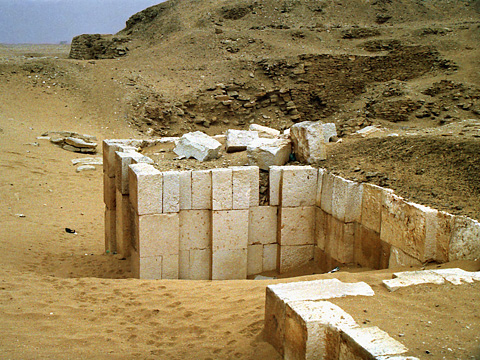Pyramid Complex of Sekhemkhet
Sekhemkhet (Djeserty) was the successor to Djoser, whose Step Pyramid at Saqqara is well known. Sekhemkhet ruled for only 6 years, and his pyramid, which may have been intended to be larger than that of Djoser, never rose much above ground level. For this reason the monument is known as the ‘Buried Pyramid’ and it is located to the south-west of the Unas complex.

Sekhemkhet’s previously unknown structure was excavated in the 1950s by Zakaria Goneim, an Egyptian archaeologist who had become interested in the mysterious rectangular shape in the desert while he was excavating at the Unas complex. He first discovered a section of a white limestone enclosure wall (the whole perimeter wall measures approximately 500m by 185m). The wall, which had later been extended on the northern and southern sides, had niches and false doors similar to the enclosure wall of the step pyramid, and is very well-preserved. Also found on a block in the enclosure wall was a mason’s inscription in red ink, which includes the name of Imhotep, Djoser’s architect.

Little is really known about the intended structure, although archaeologists suggest (from the size of the square base) that it probably would have been higher than Djoser’s monument and it may have had 7 steps planned instead of 6.
The next stage in Goneim’s investigations revealed an open rock-cut trench on the northern side of the enclosure, which was blocked by masonry. The entrance led to a passage, ending in a burial chamber right under the centre of the pyramid and 30m below ground. The name of Sekhemkhet was found on seal impressions on vessels in the corridor which gave the identification of the pyramid’s owner. Much progress seems to have been made on the monument’s substructure. A U-shaped corridor opens from the descending passage to other unfinished galleries around the burial chamber and the corridor was interrupted by a vertical shaft again similar to the shaft in Djoser’s structure.

Goneim found a great number and variety of objects during clearance of the debris, including animal bones, demotic papyri (from later periods) and a large hoard of Dynasty III stone vessels similar to Djoser’s ‘heirlooms’. The excavator’s greatest surprise was to see his first ‘gleam of gold’ – the contents of a decayed wooden casket which had contained a presumably undisturbed funerary deposit of 21 gold bracelets, a hinged gold cosmetic box in the form of a shell, electrum tweezers and a needle, and many gold, carnelian and faience beads. Sealed jars were inscribed with Sekhemkhet’s name, as was an ivory label bearing a list of linens. Goneim was convinced he had found an intact burial which had escaped the tomb-robbers and there was a great deal of excitement among state officials and the press. This was among the oldest treasures found in Egypt.
Continuing the excavations Goneim eventually reached the burial chamber which was blocked by a wall of stone masonry. Inside the chamber, which was rough-cut and undecorated, stood a highly-polished alabaster sarcophagus (still in situ) carved from a single piece of stone and uniquely blocked at one end with a sliding stone panel plastered into position. The sarcophagus was opened on 26 June 1954 with great ceremony – but to the huge disappointment of the excavator and the crowd, it was empty.
Zakaria Goneim’s sensational discovery of the ‘Buried Pyramid’ with its hoard of treasures ended in tragedy in 1959 when he committed suicide at the height of his career.
In 1963, Jean-Philippe Lauer took up the excavation of Sekhemkhet’s monument by investigating the possibility of a south tomb, a feature which he had found on the southern side of Djoser’s Step Pyramid. He also wanted to reconstruct a plan of the Buried Pyramid and to try to resolve the mystery of the missing mummy. Lauer uncovered the foundations of the south tomb below a destroyed mastaba. In a corridor at the bottom of a deep shaft, he found remains of an early wooden coffin which contained the bones of a two-year old boy (a royal prince?) with some Dynasty III vessels and gold leaf fragments. The burial chamber had been looted by robbers. Lauer went on to prove Goneim’s theory that the enclosure wall of the complex had been extended. There are many theories surrounding the Buried Pyramid and its lack of completion which still remain a mystery.
Today there is little to see at the Buried Pyramid complex, except the lower courses of the enclosure wall, the entrance to the descending corridor and the deep shaft of the south tomb.
